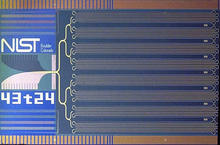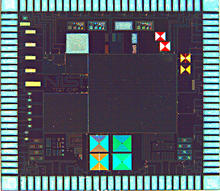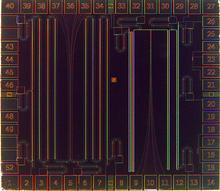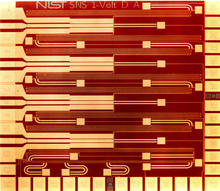1990s - History of NIST Quantum Voltage Standards
1992
NIST fabricated the first 10-volt chip made of all-niobium superconducting electrodes, which made it less susceptible to damage from handling and contamination. The chip is 10 millimeters by 20 millimeters in size and has 20,208 junctions made of niobium electrodes with aluminum-oxide barriers. The circuit design and fabrication process was transferred to industry and became the basis for the first commercial superconducting quantum voltage standard.
(Artifact 6)

1995
In an advance toward programmable standards, NIST demonstrated the first quantized voltage steps in an array of Josephson junctions with barriers made of normal metal instead of an insulator. The circuit contains 400 junctions, 1.7 micrometers by 1.7 micrometers in size, made of niobium electrodes and gold-palladium alloy barriers. The photograph of oscilloscope traces shows two superimposed current-voltage curves, with and without an applied microwave signal. Clark Hamilton of NIST suggested the idea of a normal-metal barrier in 1991. Programmable arrays provide a new feature—intrinsically stable quantized steps that can be turned on and off easily to produce any desired voltage. However, each junction contributes just one quantum of voltage to the total; programmable standards require more junctions than the original standards to reach the same voltage.
(Artifact 7, Citation: S. P. Benz, "Superconductor-normal-superconductor junctions for programmable voltage standards," Appl. Phys. Lett., vol. 67, pp. 2714-2716, Oct. 1995.)

1996
Laying the groundwork to produce highly accurate ac voltages, NIST researchers used this circuit with 512 Josephson junctions to measure the first quantized voltage steps produced with a pulse-driven waveform. The junctions are made of niobium electrodes with gold-palladium alloy barriers. Although the voltages were only a few hundred microvolts, the measurement demonstrated that accurate voltages could be synthesized with a pulse-driven waveform and that the voltage was exactly proportional to the number of pulses.
The idea of using current pulses arose during a meeting in July 1995 between Clark Hamilton and Sam Benz of NIST and John Przybysz and Hodge Worsham of Westinghouse Electric Corp. When a single junction or an array of junctions is driven by a series of current pulses instead of a steady microwave source, the average voltage is proportional to the pulse rate, and by changing the rate with time it is possible to accurately synthesize a specified voltage waveform. The photograph of the oscilloscope trace shows the first measurement of quantized voltage steps driven by pulses.
(Artifact 11, Citation: S. P. Benz and C. A. Hamilton, "A pulse-driven programmable Josephson voltage standard," Appl. Phys. Lett. , vol. 68, pp. 3171-3173, 27 May 1996.)

1997
NIST made the first programmable 1-volt standard, which had 32,768 junctions on a 1-centimeter square chip. This was the first demonstration of the new normal-metal junction barrier technology that produced large numbers of junctions with uniform electrical characteristics, even though each junction is only 2 micrometers by 2 micrometers in size. Programmable arrays are ideal for automated measurement systems. The stability of the programmable steps enabled the first detailed characterization of voltmeters.
(Artifact 8, Citation: S. P. Benz et al, "Stable 1-volt Programmable Voltage Standard," Appl. Phys. Lett. vol. 71, no. 13, pp. 1866-8, Sept. 1997)(Artifact 3, Citation: C.A. Hamilton , F. L. Lloyd, K. Chieh, & W.C. Goeke, IEEE Trans. Inst. Meas. Vol. 38, April 1989, pp. 314-316)


